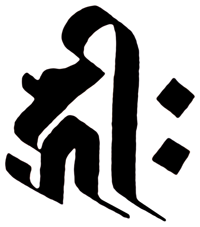
In a previous article I looked into the seed syllable of Perfect Wisdom. Wisdom is always matched and balanced by compassion in Buddhism so I thought I'd take a look at the seed syllable of Amitābha, the Buddha of Compassion, hrīḥ or ह्रीः or ཧྲཱིཿ, pronounced /hriːh/ (IPA). Hrīḥ is also the seed syllable for the Bodhisattva Avalokiteśvara or as the Tibetans call him Chenrezig, who is closely associated with Amitābha. In the system of Tantra magic they are all associated the with the Red Rite.
However even less is written about hrīḥ than about dhīḥ. One source is Lama Govinda's book The Foundations of Tibetan Mysticism. Despite the fact that he was a friend of my main Buddhist teacher, and his book is recommended by some of my Buddhist friends, I've come to be wary of Govinda's interpretations. His exegesis on mantra is informed more by Upanishads than Buddhist texts, as is evident from the sources which he quotes on the subject. The Buddhist view on mantra has some distinctions from the Vendantic. With the caveat let's look at what Govinda says.
By the time of the Buddha, the Vedantic scholar priests were beginning to break magical syllables such as oṃ into their theoretical component parts. They also adopted the diphthongised version of the syllable, i.e. auṃ (ओं > औं or ॐ). So it's a common place thing to see auṃ analysed as a + u + ṃ or anusvāra (the nasalisation symbol). This practice was also adopted by Vajrayana Buddhists, though Buddhists stuck with oṃ. So we would expect hrīḥ to be analysed into four part: ha + ra + ī + ḥ, i.e. visarga or aspirated vowel symbol. Govinda however says that as the Tibetans seldom pronounce the visarga (which is usually described as a soft echo of the preceding vowel) and that they analyse only three sounds. H according to this scheme symbolises : "the breath, the symbol of all life"; while R is "the sound of fire", and I is "the vowel of high intensity and stands for the highest spiritual activity and differentiation".[1]
Later Govinda describes hrīḥ as the "inner voice, the moral law within us, the voice of conscience, of inner knowledge" which suggests that he is linking it with the Vedic word hrī (Pali hiri). The form hrīḥ would be the nominative singular, i.e. hrī as subject. Hrī is defined as "modesty" and occurs in the list of 51 positive mental events in the Sarvāstivādin Abhidharma. Modesty is mentioned in the Mahāvairocana Abhisambodhi Tantra (MAT):
A son or daughter of good family who has modesty will quickly achieve two factors in this very world: they will not do what should not be done and they will be praised by the Holy Ones. There are a further two: the will realize what they have not yet realized and they will gain companionship with the Bodhisattva's and Buddhas. There are a further two: they will abide in moral discipline and they will attain birth as humans and gods.[2]
I'm not sure of the link with the qualities of compassion or with Amitābha or Avalokiteśvara. However hrīḥ, like Amitābha, also according to Govinda, involves solar symbolism. He links this with what he calls the emotional principle of goodness, compassion and sympathy, as well as with the illuminating aspects of the sun: light, making things visible, the faculty of perception, of direct vision. In a flight of poetic imagination, and forgetting that he has omitted the visarga (ḥ), he describes hrīḥ as "a mantric solar symbol, a luminous, elevating, upwards moving sound composed of the pranic aspirate [ie the visarga], the fiery R... " and the high vowel which he says "expresses upwards-movement, intensity", etc.[3]
Unfortunately Govinda offers no source for this. The association for ra, or raṃ, is an Vedantic one, but the others may well be Govinda's own interpretation. What he writes about 'i' sounds as if it is influenced by 20th century Phonetics which describes the long ī as the "unrounded-high-front vowel".
This kind of analysis is possible in esoteric Buddhism. According to the MAT, 'H' is hetu or cause in the sense of original cause, and 'R' is raja or defilement - the point being that dharmas lack either. The MAT doesn't do vowels and doesn't have anything to say about the visarga. But Kūkai treats the alphabet more comprehensively: H is cause, R is taint, I is senses, and Visarga is release. [4] This kind of analysis has its roots in the Prajñāpāramitā or Perfection of Wisdom tradition and is found in the larger texts like the Perfection of Wisdom in 25,000 lines. Before that there are links back to the Abhidharma tradition.
Amitābha being incredibly popular in the wake of Pure Land Buddhism, his seed syllable can be found everywhere in Japan - including rather ironically decorating samurai swords and other war gear.
~~oOo~~
References
- Govinda, Lama. 1959. Foundations of Tibetan Mysticism. (London : Rider). p.183, note 1.
- Hodge, Stephen. 2003. The Maha-Vairocana-Abhisambodhi Tantra : with Buddhaguhya’s commentary. (London : RoutledgeCurzon). p.168. (=MAT vi.9)
- Govinda, ibid p.231.
- Abe, Ryuchi. 1999. The Weaving of Mantra. (New York : Columbia University Press). p.291-2
Some of my calligraphy of hṛīḥ
My calligraphy website has more examples of hrīḥ.









